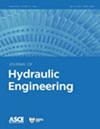求助PDF
{"title":"Modifications to the Single Point Velocity Measurement Method for Estimating River Discharge in Low-Resource Environments","authors":"Ghadeer Ali, M. Maghrebi","doi":"10.1061/jhend8.hyeng-13469","DOIUrl":null,"url":null,"abstract":": Accurate and reliable river discharge evaluation at a river station is an essential piece of information to obtain. This work modifies a power-law (PL)-based model and a single point velocity measurement (SPM) method for calculating channel discharge. Specifically, modifications are proposed for the constant shear velocity assumption, water surface effects, the underlying velocity distribution, and the number of measurements. A coefficient of water surface ( cw ) is proposed to consider the impact of water surface on distribution of velocity. Additionally, a power-wake-law (PWL) method is proposed to cope with the velocity dip phenomenon, where the maximum velocity occurs below the water surface. A critical assessment of the performance of the modifications using laboratory and field data is introduced. A trial-and-error procedure is applied to the laboratory data to obtain the value of the proposed coefficient cw and the parameters of PWL velocity distribution, α and β . It is found that cw ¼ 0 . 3 , α ¼ 1 . 5 = m, and β ¼ 0 . 6 are the most appropriate values that produce minimum errors in most cases. A combination approach is applied to the field data to demonstrate the performance of the modifications and the impact of increasing the number of measurements. It is found that considering a water surface effect has significantly improved the accuracy. Also, it is found that the modified PL-and PWL-based models can estimate discharge with a reasonable accuracy using five measured velocimetry points in most tested cross-sections. In most studied rivers, the five-point combinations reduce the mean absolute percentage error (MAPE) value to less than 5%. DOI: 10.1061/JHEND8.HYENG-13469. © 2023 American Society of Civil Engineers.","PeriodicalId":16046,"journal":{"name":"Journal of Hydraulic Engineering","volume":" ","pages":""},"PeriodicalIF":2.1000,"publicationDate":"2023-11-01","publicationTypes":"Journal Article","fieldsOfStudy":null,"isOpenAccess":false,"openAccessPdf":"","citationCount":"0","resultStr":null,"platform":"Semanticscholar","paperid":null,"PeriodicalName":"Journal of Hydraulic Engineering","FirstCategoryId":"5","ListUrlMain":"https://doi.org/10.1061/jhend8.hyeng-13469","RegionNum":3,"RegionCategory":"工程技术","ArticlePicture":[],"TitleCN":null,"AbstractTextCN":null,"PMCID":null,"EPubDate":"","PubModel":"","JCR":"Q2","JCRName":"ENGINEERING, CIVIL","Score":null,"Total":0}
引用次数: 0
引用
批量引用
低资源环境下估算河流流量的单点流速测量方法的改进
:河流站点准确可靠的河流流量评估是获取的重要信息。这项工作修改了基于幂律(PL)的模型和单点流速测量(SPM)方法来计算河道流量。具体而言,对恒定剪切速度假设、水面效应、潜在速度分布和测量次数提出了修改意见。为了考虑水面对流速分布的影响,提出了水面系数(cw)。此外,还提出了一种功率尾流定律(PWL)方法来处理最大速度出现在水面以下的速度下降现象。介绍了利用实验室和现场数据对改造性能的关键评估。将试错程序应用于实验室数据,以获得所提出的系数cw的值以及PWL速度分布参数α和β。发现cw¼0。3,α¼1。5=m,且β¼0。6是在大多数情况下产生最小误差的最合适的值。将组合方法应用于现场数据,以证明修改的性能和增加测量次数的影响。研究发现,考虑水面效应显著提高了精度。此外,还发现,在大多数测试截面中,使用五个测量的测速点,基于PL和PWL的修正模型可以以合理的精度估计流量。在大多数研究的河流中,五点组合将平均绝对百分比误差(MAPE)值降低到5%以下。DOI:10.1061/JHEND8.HYENG-13469。©2023美国土木工程师学会。
本文章由计算机程序翻译,如有差异,请以英文原文为准。


